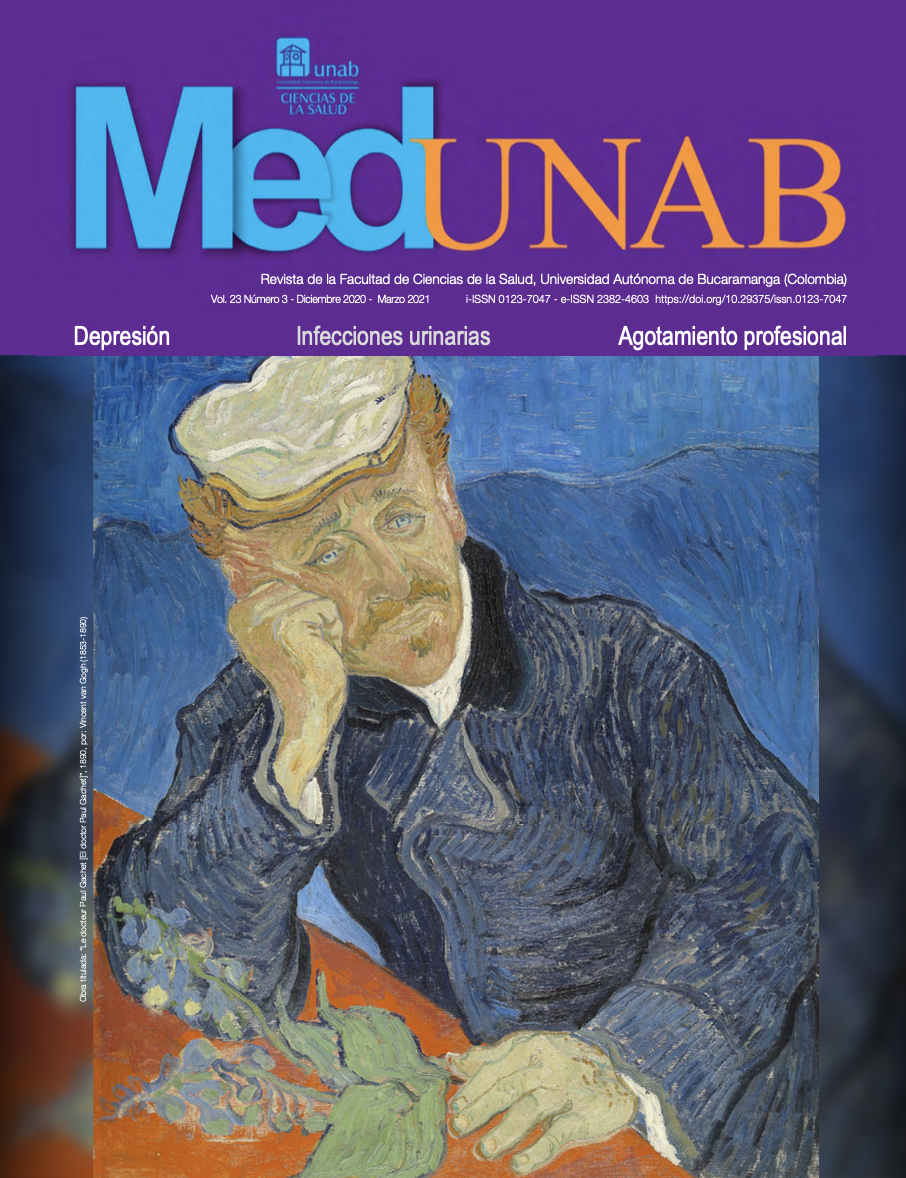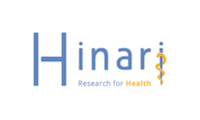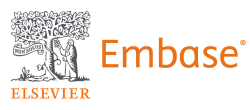Reversión de anticoagulantes orales directos: una perspectiva desde Urgencias
Resumen
Introducción. El sangrado en contexto de anticoagulación es uno de los riesgos que tienen ciertos pacientes durante determinados tratamientos, y es potencialmente mortal. Es importante conocer la farmacocinética de estas moléculas para predecir cuál será su comportamiento. Además se requiere juicio clínico en todos los casos de sangrado para determinar el manejo de acuerdo a la severidad. El objetivo de esta revisión es presentar un enfoque del paciente anticoagulado con sangrado en el servicio de urgencias. Temas tratados. Farmacocinética y farmacodinámica, generalidades, sangrado mayor y no mayor, opciones de reversión y tratamiento. Conclusión. En presencia de anticoagulantes orales directos (DOACS) se debe evaluar la gravedad del sangrado y el grado de anticoagulación, pues las estrategias de manejo se orientan dependiendo de si se trata de un sangrado mayor o menor.
Referencias bibliográficas
Chen A, Stecker E, A Warden B. Direct Oral Anticoagulant Use: A Practical Guide to Common Clinical Challenges. J Am Heart Assoc [Internet]. 2020 Jun 15 [citado 2020 Jun 27];e017559. Disponible en: http://www.ncbi.nlm.nih.gov/pubmed/32538234
Ho KH, Van Hove M, Leng G. Trends in anticoagulant prescribing: A review of local policies in English primary care [Internet]. Vol. 20, BMC Health Services Research. BioMed Central Ltd.; 2020 [citado 2020 Jun 27]. p. 279. https://doi.org/10.1186/s12913-020-5058-1
Ruff CT, Giugliano RP, Braunwald E, Hoffman EB, Deenadayalu N, Ezekowitz MD, et al. Comparison of the efficacy and safety of new oral anticoagulants with warfarin in patients with atrial fibrillation: A meta-analysis of randomised trials. Lancet [Internet]. 2014 [citado 2020 Jun 27];383(9921):955-62. https://doi.org/10.1016/S0140-6736(13)62343-0
Providência R, Grove EL, Husted S, Barra S, Boveda S, Morais J. A meta-analysis of phase III randomized controlled trials with novel oral anticoagulants in atrial fibrillation: Comparisons between direct thrombin inhibitors vs. factor Xa inhibitors and different dosing regimens. Thromb Res [Internet]. 2014 Dec 1 [citado 2020 Jun 28];134(6):1253-64. https://doi.org/10.1016/j.thromres.2014.10.002
Blech S, Ebner T, Ludwig-Schwellinger E, Stangier J, Roth W. The metabolism and disposition of the oral direct thrombin inhibitor, dabigatran, in humans. Drug Metab Dispos [Internet]. 2008 Feb [citado 2020 Jun 28];36(2):386-99. https://doi.org/10.1124/dmd.107.019083
Stangier J. Clinical pharmacokinetics and pharmacodynamics of the oral direct thrombin inhibitor dabigatran etexilate [Internet]. Vol. 47, Clinical Pharmacokinetics. Clin Pharmacokinet; 2008 [citado 2020 Jun 28]. p. 285-95. https://doi.org/10.2165/00003088-200847050-00001
Eriksson BI, Quinlan DJ, Weitz JI. Comparative pharmacodynamics and pharmacokinetics of oral direct thrombin and factor Xa inhibitors in development [Internet]. Vol. 48, Clinical Pharmacokinetics. Clin Pharmacokinet; 2009 [citado 2020 Jun 28]. p. 1-22. https://doi.org/10.2165/0003088-200948010-00001
Cui Y, Song Y, Wang J, Yu Z, Schuster A, Barrett YC, et al. Single- and multiple-dose pharmacokinetics, pharmacodynamics, and safety of apixaban in healthy Chinese subjects. Clin Pharmacol Adv Appl [Internet]. 2013 Dec 6 [citado 2020 Jun 28];5:177-84. Disponible en: /pmc/articles/PMC3861362/?report=abstract
He K, Luettgen JM, Zhang D, He B, Grace JE, Xin B, et al. Preclinical pharmacokinetics and pharmacodynamics of apixaban, a potent and selective factor Xa inhibitor. Eur J Drug Metab Pharmacokinet [Internet]. 2011 Sep [citado 2020 Jun 28];36(3):129-39. https://doi.org/10.1007/s13318-011-0037-x
Tamargo J. Edoxabán. Propiedades farmacocinéticas y farmacodinámicas. Rev Esp Cardiol Supl [Internet]. 2016 Jan 1 [citado 2020 Jun 26];16:60-6. https://doi.org/10.1016/S1131-3587(16)30017-6
Tomaselli GF, Mahaffey KW, Cuker A, Dobesh PP, Doherty JU, Eikelboom JW, et al. 2017 ACC Expert Consensus Decision Pathway on Management of Bleeding in Patients on Oral Anticoagulants: A Report of the American College of Cardiology Task Force on Expert Consensus Decision Pathways. J Am Coll Cardiol [Internet]. 2017 Dec 19 [citado 2020 Jun 28];70(24):3042-67. https://doi.org/10.1016/j.jacc.2017.09.1085
Schulman S, Kearon C. Definition of major bleeding in clinical investigations of antihemostatic medicinal products in non-surgical patients [Internet]. Vol. 3, Journal of Thrombosis and Haemostasis. J Thromb Haemost; 2005 [citado 2020 Jun 27]. p. 692-4. https://doi.org/10.1111/j.1538-7836.2005.01204.x
Samuelson BT, Cuker A, Siegal DM, Crowther M, Garcia DA. Laboratory Assessment of the Anticoagulant Activity of Direct Oral Anticoagulants: A Systematic Review. Chest [Internet]. 2017 Jan 1 [citado 2020 Jun 27];151(1):127-38. https://doi.org/10.1016/j.chest.2016.08.1462
Shih AW, Crowther MA. Reversal of direct oral anticoagulants: A practical approach. Hematology [Internet]. 2016 [citado 2020 Jun 28];2016(1):612-9. https://doi.org/10.1182/asheducation-2016.1.612
Syed YY. Idarucizumab: A review as a reversal agent for dabigatran [Internet]. Vol. 16, American Journal of Cardiovascular Drugs. Springer International Publishing; 2016 [citado 2020 Jun 28]. p. 297-304. https://doi.org/10.1007/s40256-016-0181-4
Pollack C V., Reilly PA, Eikelboom J, Glund S, Verhamme P, Bernstein RA, et al. Idarucizumab for Dabigatran Reversal. N Engl J Med [Internet]. 2015 Aug 6 [citado 2020 Jun 28];373(6):511-20. https://doi.org/10.1056/NEJMoa1502000
Khadzhynov D, Wagner F, Formella S, Wiegert E, Moschetti V, Slowinski T, et al. Effective elimination of dabigatran by haemodialysis: A phase I single-centre study in patients with end-stage renal disease. Thromb Haemost [Internet]. 2013 Feb 7 [citado 2020 Jun 28];109(4):596-605. https://doi.org/10.1160/TH12-08-0573
Siegal DM. Managing target-specific oral anticoagulant associated bleeding including an update on pharmacological reversal agents. J Thromb Thrombolysis [Internet]. 2015 [citado 2020 Jun 28];39(3):395-402. https://doi.org/10.1007/s11239-015-1167-9
Crowther M, Crowther MA. Antidotes for novel oral anticoagulants: Current status and future potential. Arterioscler Thromb Vasc Biol [Internet]. 2015 agosto 25 [citado 2020 Jun 28];35(8):1736-45. https://doi.org/10.1161/ATVBAHA.114.303402
Eerenberg ES, Kamphuisen PW, Sijpkens MK, Meijers JC, Buller HR, Levi M. Reversal of rivaroxaban and dabigatran by prothrombin complex concentrate: A randomized, placebo-controlled, crossover study in healthy subjects. Circulation [Internet]. 2011 Oct 4 [citado 2020 Jun 28];124(14):1573-9. https://doi.org/10.1161/CIRCULATIONAHA.111.029017
M L, KT M, CF C, D K, SD B, SZ G, et al. Comparison of Three-Factor and Four-Factor Prothrombin Complex Concentrates Regarding Reversal of the Anticoagulant Effects of Rivaroxaban in Healthy Volunteers. J Thromb Haemost [Internet]. 2014 [citado 2020 Jun 28];12(9). https://doi.org/10.1111/jth.12599
Zahir H, Brown KS, Vandell AG, Desai M, Maa JF, Dishy V, et al. Edoxaban effects on bleeding following punch biopsy and reversal by a 4-factor prothrombin complex concentrate. Circulation [Internet]. 2015 [citado 2020 Jun 28];131(1):82-90. https://doi.org/10.1161/CIRCULATIONAHA.114.013445
Descargas
| Estadísticas de artículo | |
|---|---|
| Vistas de resúmenes | |
| Vistas de PDF | |
| Descargas de PDF | |
| Vistas de HTML | |
| Otras vistas | |
































